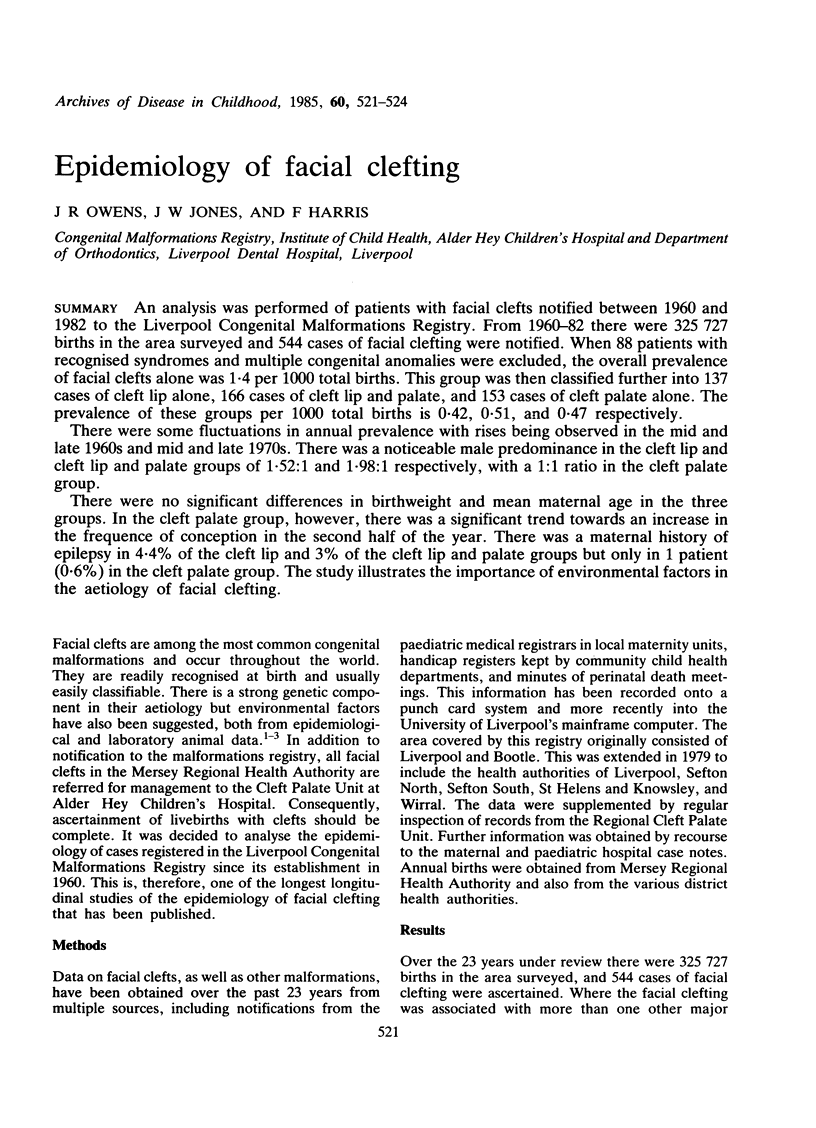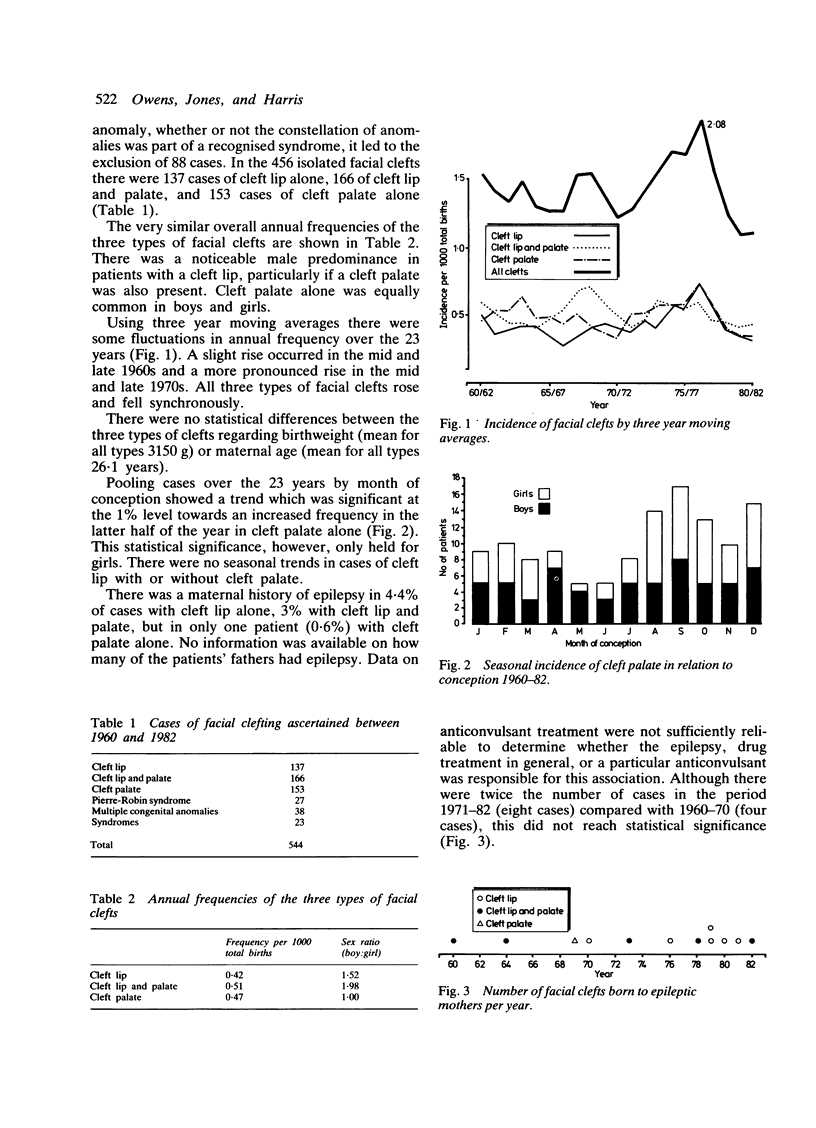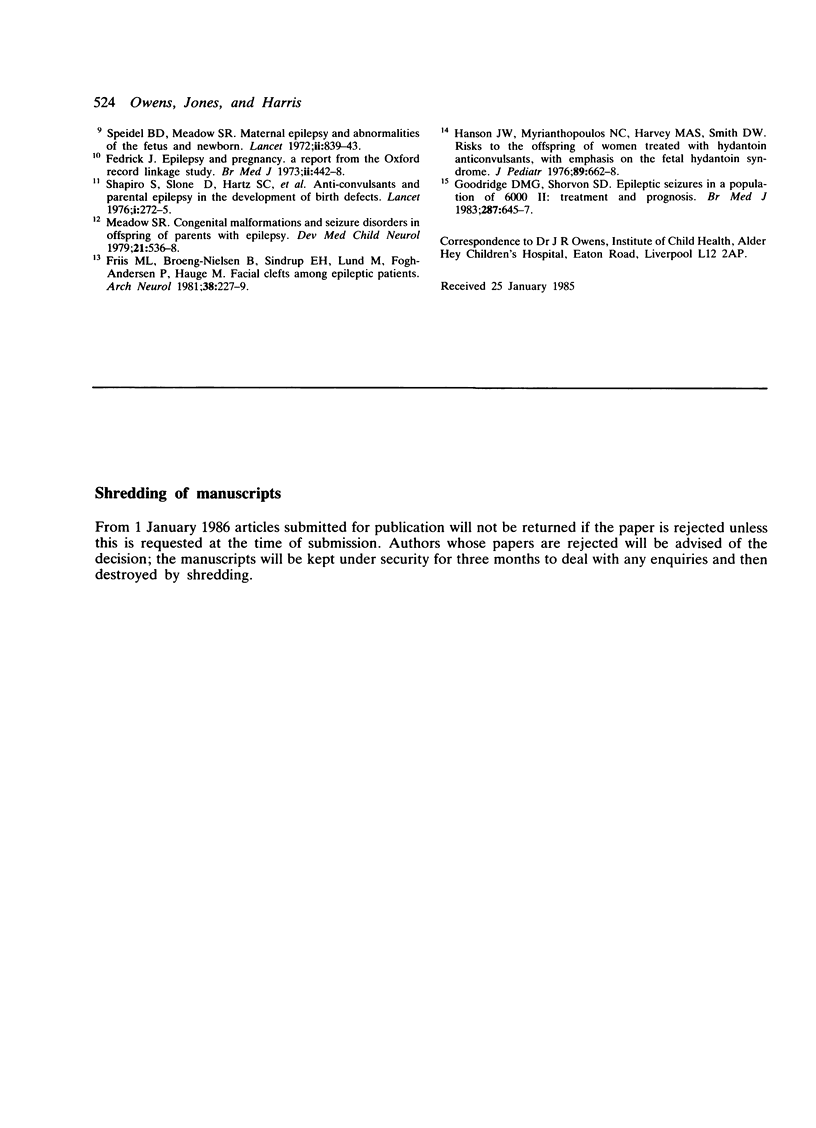Abstract
An analysis was performed of patients with facial clefts notified between 1960 and 1982 to the Liverpool Congenital Malformations Registry. From 1960-82 there were 325 727 births in the area surveyed and 544 cases of facial clefting were notified. When 88 patients with recognised syndromes and multiple congenital anomalies were excluded, the overall prevalence of facial clefts alone was 1.4 per 1000 total births. This group was then classified further into 137 cases of cleft lip alone, 166 cases of cleft lip and palate, and 153 cases of cleft palate alone. The prevalence of these groups per 1000 total births is 0.42, 0.51, and 0.47 respectively. There were some fluctuations in annual prevalence with rises being observed in the mid and late 1960s and mid and late 1970s. There was a noticeable male predominance in the cleft lip and cleft lip and palate groups of 1.52:1 and 1.98:1 respectively, with a 1:1 ratio in the cleft palate group. There were no significant differences in birthweight and mean maternal age in the three groups. In the cleft palate group, however, there was a significant trend towards an increase in the frequence of conception in the second half of the year. There was a maternal history of epilepsy in 4.4% of the cleft lip and 3% of the cleft lip and palate groups but only in 1 patient (0.6%) in the cleft palate group. The study illustrates the importance of environmental factors in the aetiology of facial clefting.
Full text
PDF



Selected References
These references are in PubMed. This may not be the complete list of references from this article.
- EDWARDS J. H. Seasonal incidence of congenital disease in Birmingham. Ann Hum Genet. 1961 May;25:89–93. doi: 10.1111/j.1469-1809.1961.tb01502.x. [DOI] [PubMed] [Google Scholar]
- FRASER F. C., WALKER B. E., TRASLER D. G. Experimental production of congenital cleft palate: genetic and environmental factors. Pediatrics. 1957 Apr;19(4 Pt 2):782–787. [PubMed] [Google Scholar]
- FRASER G. R., CALNAN J. S. Cleft lip and palate: seasonal incidence, birth weight, birth rank, sex, site, associated malformations and parental age. A statistical survey. Arch Dis Child. 1961 Aug;36:420–423. doi: 10.1136/adc.36.188.420. [DOI] [PMC free article] [PubMed] [Google Scholar]
- Fedrick J. Epilepsy and pregnancy: a report from the Oxford Record Linkage Study. Br Med J. 1973 May 26;2(5864):442–448. doi: 10.1136/bmj.2.5864.442. [DOI] [PMC free article] [PubMed] [Google Scholar]
- Fris M. L., Broeng-Nielsen B., Sindrup E. H., Lund M., Fogh-Andersen P., Hauge M. Facial clefts among epileptic patients. Arch Neurol. 1981 Apr;38(4):227–229. doi: 10.1001/archneur.1981.00510040053008. [DOI] [PubMed] [Google Scholar]
- Goodridge D. M., Shorvon S. D. Epileptic seizures in a population of 6000. II: Treatment and prognosis. Br Med J (Clin Res Ed) 1983 Sep 3;287(6393):645–647. doi: 10.1136/bmj.287.6393.645. [DOI] [PMC free article] [PubMed] [Google Scholar]
- Hanson J. W., Myrianthopoulos N. C., Harvey M. A., Smith D. W. Risks to the offspring of women treated with hydantoin anticonvulsants, with emphasis on the fetal hydantoin syndrome. J Pediatr. 1976 Oct;89(4):662–668. doi: 10.1016/s0022-3476(76)80414-3. [DOI] [PubMed] [Google Scholar]
- Kalter H. The Inheritance of Susceptibility to the Teratogenic Action of Cortisone in Mice. Genetics. 1954 Mar;39(2):185–196. doi: 10.1093/genetics/39.2.185. [DOI] [PMC free article] [PubMed] [Google Scholar]
- Keys D. W. Hand, foot and mouth disease. Aust Dent J. 1974 Feb;19(1):1–3. doi: 10.1111/j.1834-7819.1974.tb05010.x. [DOI] [PubMed] [Google Scholar]
- Leck I. The etiology of human malformations: insights from epidemiology. Teratology. 1972 Jun;5(3):303–314. doi: 10.1002/tera.1420050305. [DOI] [PubMed] [Google Scholar]
- MACMAHON B., MCKEOWN T. The incidence of harelip and cleft palate related to birth rank and maternal age. Am J Hum Genet. 1953 Jun;5(2):176–183. [PMC free article] [PubMed] [Google Scholar]
- Meadow R. Congenital malformations and seizure disorders in offspring of parents with epilepsy. Dev Med Child Neurol. 1979 Aug;21(4):536–538. doi: 10.1111/j.1469-8749.1979.tb01661.x. [DOI] [PubMed] [Google Scholar]
- Shapiro S., Hartz S. C., Siskind V., Mitchell A. A., Slone D., Rosenberg L., Monson R. R., Heinonen O. P. Anticonvulsants and parental epilepsy in the development of birth defects. Lancet. 1976 Feb 7;1(7954):272–275. doi: 10.1016/s0140-6736(76)91403-3. [DOI] [PubMed] [Google Scholar]
- Speidel B. D., Meadow S. R. Maternal epilepsy and abnormalities of the fetus and newborn. Lancet. 1972 Oct 21;2(7782):839–843. doi: 10.1016/s0140-6736(72)92209-x. [DOI] [PubMed] [Google Scholar]
- Welch J., Hunter A. G. An epidemiological study of facial clefting in Manitoba. J Med Genet. 1980 Apr;17(2):127–132. doi: 10.1136/jmg.17.2.127. [DOI] [PMC free article] [PubMed] [Google Scholar]


